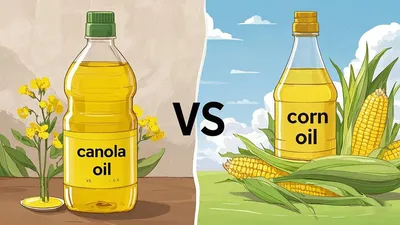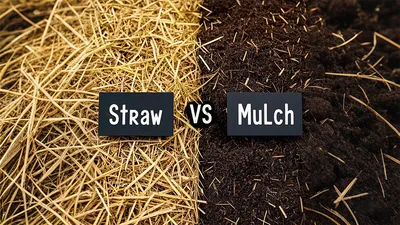
Comparison Table
| Comparison Criteria | Olive Oil | Coconut Oil | Notes |
|---|---|---|---|
| Smoke Point (Refined) | 465°F (240°C) | 350°F (177°C) | If oil has a higher smoke point, it is less likely to oxidize during frying. Well-suited for high-heat culinary tasks. |
| Saturated Fat Content | 14% | 92% | The saturated fat in coconut oil might boost good cholesterol, but there are worries about its impact on bad cholesterol. |
| Monounsaturated Fat (MUFA) | 73% | 6% | The MUFAs found in olive oil are beneficial for heart health and can reduce inflammation. |
| Polyunsaturated Fat (PUFA) | 11% | 2% | The reduced PUFA in coconut oil decreases the chances of oxidation during frying. |
| Vitamin E Content | 1.94mg/100g | 0.20mg/100g | Olive oil is rich in antioxidants, which combat oxidative stress. |
| Vitamin K Content | 60.2µg/100g | 0.6µg/100g | For blood clotting and strong bones, olive oil is very important. |
| Cholesterol Content | 0mg | 0mg | Neither oil contains cholesterol. Both are beneficial for heart health. |
| Oxidative Stability | Moderate | High | Saturated fats are the reason why coconut oil remains stable and does not go rancid easily. |
| Flavor Transfer | Mild to strong | Neutral | The culinary uses of olive oil are versatile, offering different flavor notes. |
| Heart Health Benefits | Reduces LDL, boosts HDL | May increase LDL | The Mediterranean diet, rich in olive oil, is connected to a decreased risk of cardiovascular problems. |
| Medium-Chain Triglycerides (MCTs) | Negligible | 65% MCTs | The MCTs found in coconut oil help boost quick energy production. |
| Antioxidant Content | High (polyphenols) | Low | Olive oil has polyphenols which are known to fight inflammation. These polyphenols also counteract oxidative damage. |
| Weight Management | Moderate | Promotes satiety | MCTs found in coconut oil might help with appetite regulation. |
| Smoke Point (Unrefined) | 375°F (190°C) | 350°F (177°C) | Refined olive oil is more suitable for high-heat frying compared to unrefined types. |
| Shelf Life | 12-18 months | 24 months | With greater stability, coconut oil lasts longer and minimizes waste. |
| Environmental Impact | Low water use | High water use | The low irrigation needs of olive farming make it a great choice for arid zones. |
| Production Sustainability | Moderate (pesticide use) | Low-input crop | Coconut palms thrive with minimal agrochemicals. Additionally, they contribute to biodiversity. |
| Carbon Footprint | Higher (processing) | Lower | When coconut oil is extracted, the amount of CO2 emitted is smaller. |
| Allergen Potential | None | None | These oils are hypoallergenic. They pose no risk to most dietary restrictions. |
| Religious Dietary Compliance | Hindu, Halal, Kosher | Widely accepted | Coconut oil fits within the rules of vegan, paleo, and most religious diets. |
| Traditional Use | Mediterranean diets | Tropical cuisines | The consumption of olive oil is essential for the long life spans seen in Blue Zones. |
| Cost per Liter (Global Avg) | $8-$15 | $5-$10 | Coconut oil is less expensive in tropical areas. |
| Availability | Global | Widespread in Asia/Pacific | In Southeast Asia, coconut oil plays a major role in cooking practices. |
| Energy Content | 800kcal/100g | 862kcal/100g | Coconut oil supplies more concentrated energy, which is ideal for active individuals. |
| Processing Methods | Cold-pressed options | Expeller-pressed | Unrefined olive oil keeps more nutrients and flavor compounds. |
| Impact on LDL Cholesterol | Lowers LDL | May raise LDL | To follow WHO advice on heart disease, olive oil is a recommended choice. |
| Anti-Inflammatory Properties | High (oleocanthal) | Moderate | One of the components of olive oil, oleocanthal, acts like ibuprofen. |
| Cooking Versatility | Sautéing, frying, dressings | Frying, baking | Olive oil performs beautifully under high heat. It's also ideal when used raw. |
| Thermal Degradation | Moderate | Resistant | Coconut oil performs better at keeping its structure when used for extended frying. |
| Historical Usage | 6,000+ years | 2,000+ years | Olive oil has been an integral part of Mediterranean culture for centuries. |
| Storage Requirements | Cool, dark place | Room temperature stable | Coconut oil solidifies naturally. It doesn't require refrigeration. |
| Impact on HDL Cholesterol | Modest increase | Significant increase | Coconut oil has the potential to improve HDL levels better. |
| Land Use Efficiency | High yield/hectare | Moderate | Producing oil from olive groves requires a smaller area of land. |
| Global Production Leaders | Spain, Italy, Greece | Indonesia, Philippines | The region where something is produced influences its cost. It also determines how available it is. |
A Look at Olive Oil and Coconut Oil in Frying: Key Factors Examined
There is an ongoing debate about which oil is superior for frying: olive oil or coconut oil. Chefs, nutritionists, and home cooks have strong opinions on this topic. The oils have different characteristics. Whether they work well for frying is linked to their chemical nature and traditional uses. The essay analyzes the topic through different perspectives such as health outcomes, culinary practices, ecological impacts, financial aspects, and societal importance. It also integrates factual information and individual reflections for a complete answer.
Analysis of Health Benefits and Nutritional Needs
What Are the Fatty Acid Compositions? What Are the Smoke Points?
An oil's suitability for frying is mainly determined by its smoke point. This is the temperature where it begins to degrade and form harmful substances. The main components of extra virgin olive oil include 73% monounsaturated fats and polyphenols, which are beneficial antioxidants. While the smoke point is between 375°F and 405°F (190°C–207°C), it is considered less appropriate for high-temperature frying. While refined olive oil can handle heat up to 465°F (240°C) due to being purified, it lacks the nutritional benefits found in EVOO.
Coconut oil's saturated fat level reaches 92%, offering it unmatched oxidative stability. Virgin coconut oil has a smoke point of 350°F (177°C). Refined coconut oils, on the other hand, have higher smoke points ranging from 400°F to 450°F (204°C–232°C). According to a 2019 study in the Journal of Food Science, coconut oil produces less toxic aldehydes during prolonged frying than olive oil. It could therefore be considered safer for high-temperature cooking.
Cardiovascular Health Considerations
The AHA warns people about the risks of saturated fat. It can cause an increase in LDL cholesterol. While coconut oil is widely used in wellness communities, a 2020 review in Circulation indicates it boosts LDL levels in the same way as butter. Olive oil has high levels of oleic acid. Research consistently links it to a reduced risk of heart-related problems. In the 2018 PREDIMED trial, it was found that adopting a Mediterranean diet supplemented with EVOO decreased heart attacks by 30% as opposed to a low-fat diet.
Since I prioritize heart health, olive oil has become my daily essential. Coconut oil is stable enough for high-heat frying once in a while. This could make up for its high saturated fat content.
Kitchen Efficiency and Practicality
Flavor and Texture
A peppery and grassy note in olive oil makes Mediterranean dishes more flavorful. Think of Greek salads and Spanish paella. It has a powerful taste that might conflict with lighter meals. In a 2022 survey by the Culinary Institute of America, it was discovered that 68% of professional chefs choose neutral oils. Refined coconut oil and avocado oil are great options for frying without flavor contamination.
The subtle sweetness of coconut oil is great for tropical curries and desserts. It is solid at room temperature, which leads to crispier fried foods. Sri Lankan kottu roti, for example, requires coconut oil to create its distinctive crunch.
Durability in terms of reuse and oxidative conditions
Frying oils break down with repeated use and create free radicals. Coconut oil is less prone to oxidation due to its saturated fat composition. Olive oil, on the other hand, oxidizes quicker. Coconut oil was shown to retain its quality for 24 hours of frying in a 2021 study from Food Chemistry. The same study revealed that olive oil begins to degrade after 12 hours. Coconut oil turns out to be a more cost-efficient product for commercial kitchens.
Issues Related to the Environment and Economy
Production and Sustainability
The FAO states that olive oil production demands a lot of water, with 1,500–3,000 liters needed per liter of oil. Tropical climates are ideal for coconut palms. These trees can survive with minimal irrigation. Coconut farming encounters issues such as deforestation caused by monoculture in Indonesia and the Philippines.
Olive groves in Spain and Italy contribute to reducing CO2 levels. Unfortunately, mechanized harvesting adds substantially to greenhouse gas emissions. Coconut oil is more environmentally friendly in terms of carbon emissions. 5–1.This shows 0 kg CO2e per liter, whereas olive oil shows 1 kg CO2e. 5–3.According to the Sustainability journal's 2023 publication, it is 0 kg CO2e.
Cost and Accessibility
In the U.S.The cost of refined coconut oil falls within $6 to $10 per liter. Refined olive oil, on the other hand, averages $8 to $15 per liter. The cost of EVOO falls within the range of $15–$30 per liter, reflecting how much effort goes into extracting it. Coconut oil is ideal for cooks who want to save money during high-heat frying.
The Context of Culture and History
Olive Oil: A Key Ingredient in Mediterranean Cuisine
Olive oil has been a key part of Mediterranean diets for thousands of years. It was consumed as food and burned as lamp fuel by the ancient Greeks. In Italian and Spanish recipes, it is important for frying calamari and vegetables. Its cultural value is reinforced by UNESCO designating the 'Mediterranean diet' as an Intangible Cultural Heritage.
The Tropics are Known for Coconut Oil. Their Traditions Remain Strong
The use of coconut oil dates back centuries in Southeast Asia and the Pacific Islands. It is employed in both cooking and traditional healing methods. Coconut oil is favored in Ayurvedic medicine in India for its recognized 'cooling' qualities. Western markets are seeing its return. This is partly because of nostalgia for historical diets.
Science Provides the Facts. Subjectivity Adds the Context
The Positive Impact of Olive Oil
Olive oil is a top choice for health-conscious people because of its polyphenols and heart benefits. A recent study shows that daily consumption of EVOO reduces the chances of death from all causes by 25%, according to the NEJM. Its lower smoke point is a disadvantage, but this can be managed by using it for sautéing or pan-frying instead of deep-frying.
Coconut Oil Can Improve Your Life
One of the strengths of coconut oil is its high-heat stability. It also boasts a long shelf life. Medium-chain triglycerides in it are used up rapidly for energy. This appeals to people on a ketogenic diet. It has saturated fat, so it is important to eat it in moderation.
When making a Caribbean-inspired dinner, I choose coconut oil for frying plantains to get that authentic taste and crunchiness. Olive oil has grassy notes. These elevate the taste of a Greek-style zucchini fritter.
Ultimately, context is essential. It determines how we understand things.
You cannot say that one oil is always better than the other. When it comes to low or medium heat, olive oil performs beautifully. It also fits perfectly into health-conscious diets. On the other hand, coconut oil is ideal for high-heat frying and recipes that call for tropical flavors. When making the decision, one must consider nutritional priorities, culinary goals, and environmental values. In a world where global cuisines meet, using both oils appropriately may be the most logical strategy.
















